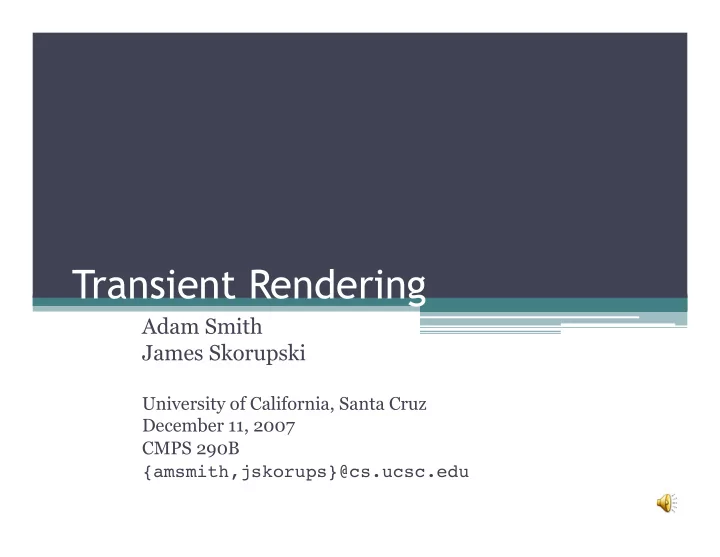

Transient Rendering Adam Smith James Skorupski University of California, Santa Cruz December 11, 2007 CMPS 290B {amsmith,jskorups}@cs.ucsc.edu
2/32 Motivation There is growing interest in time-of-flight based computer vision applications and we want some general, physical explanation of measurements we make. Our contribution: a formal model that let’s us do just that
3/32 Background • We want ▫ Rigorous analysis ▫ Specific to light ▫ Transient effects • What’s out there ▫ LIDAR ▫ SONAR ▫ Rendering Equation
4/32 LIDAR • NO: Rigorous analysis • YES: Specific to light • YES: Transient effects (UC Santa Cruz) (UC Davis)
5/32 SONAR Overview (Transponder in yellow) • YES: Rigorous analysis • NO: Specific to light • YES: Transient effects (USGS) Height field of two sunken ships (NOAA)
6/32 Rendering Equation • YES: Rigorous analysis • YES: Specific to light • NO: Transient effects (Stanford) where ▫ L is total light ▫ L 0 is emitted light ▫ G is global transport (single bounce) (Kajiya, 1986)
7/32 The Important Distinction Steady state vs. transient light transport
8/32 Visualization • Steady state: Where the light comes out
9/32 Visualization • Transient: When the light comes out
10/32 Visualization
11/32 Visualization
12/32 Visualization
13/32 Visualization
14/32 Visualization
15/32 Visualization • Note: Top pulse wins the race!
16/32 Energy vs. Power Steady State Transient Energy (Joules) Power (Watts) Number of photons received Rate of photons received Radiance Radiant flux
17/32 Infinite vs. Finite • D Steady State Transient • X, Y are points • c is the speed of light
18/32 Functions Steady State Transient • X is a point • ω is a direction • t is a time
19/32 Transient Rendering Equation (our contribution)
20/32 Transient Rendering Equation • Global light transport G is the composition of two physical processes ▫ propagation, P delays light over distances ▫ scattering, S same as traditional rendering
21/32 Example a) 1-d world with two surfaces A and B, eye E and light L a) Z E L A B b) result of transient Time rendering c) light seen at E over time b) • Input: positions, scattering kernels, initial light emission • Output: received light power at every point, every direction, and every time c) Time
22/32 Example a) 1-d world with two surfaces A and B, eye E and light L a) Z E L A B b) result of transient Time rendering c) light seen at E over time b) • Input: positions, scattering kernels, initial light emission • Output: received light power at every point, every direction, and every time c) Time
23/32 Example a) 1-d world with two surfaces A and B, eye E and light L a) Z E L A B b) result of transient Time rendering c) light seen at E over time b) • Input: positions, scattering kernels, initial light emission • Output: received light power at every point, every direction, and every time c) Time
24/32 Example a) 1-d world with two surfaces A and B, eye E and light L a) Z E L A B b) result of transient Time rendering c) light seen at E over time b) • Input: positions, scattering kernels, initial light emission • Output: received light power at every point, every direction, and every time c) Time
25/32 Example a) 1-d world with two surfaces A and B, eye E and light L a) Z E L A B b) result of transient Time rendering c) light seen at E over time b) • Input: positions, scattering kernels, initial light emission • Output: received light power at every point, every direction, and every time c) Time
26/32 Sensor Model • Turns ideal worlds into ground truth sensor readings • Takes into account: ▫ Sampled function of time ▫ Integration over shutter window ▫ Light pulse envelope ▫ Discrete photons • Produces: sequence of energy measurements
27/32 New Research Directions • Applications: do things we could not do before • Building sensors: capture transient patterns directly • Theory: generalize and compute
28/32 Some Applications • 3.0D range finding (hidden surfaces) • Subsurface scattering estimation from time instead of space samples • Model-based LIDAR applications
29/32 Building Sensors • Existing LIDAR hardware measures the data we need, but throws most of it away
30/32 Theory • Generalize ▫ Wavelength ▫ Subsurface scattering ▫ Phosphorescence • Compute ▫ Dependency calculation ▫ Function representations ▫ Augment a common raytracer
31/32 Theory • Generalize ▫ Wavelength ▫ Subsurface scattering ▫ Phosphorescence • Compute ▫ Dependency calculation ▫ Function representations ▫ Augment a common raytracer
32/32 Conclusion We have taken initial steps into exploring the effects of the light propagation delay, and called this Transient Rendering. We hope that transient rendering can serve as a principled foundation for future time-of-flight based computer vision techniques.
Recommend
More recommend